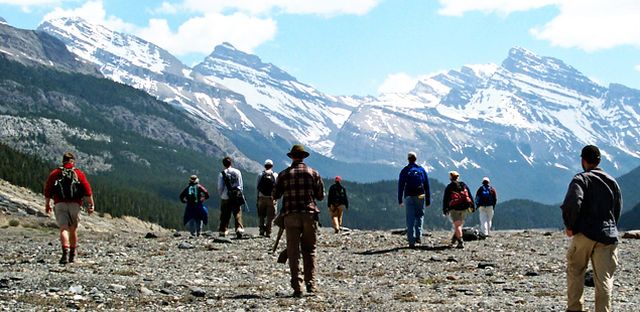
Geology Faculty Publications
Document Type
Article
Publication Date
2015
Publication Source
Nevada Bureau of Mines and Geology Map 184
Abstract
Located in central Elko County, the Welcome and adjacent part of the Wells quadrangles expose a remarkable array of critical relationships for understanding the geologic history of the State of Nevada and the interior of the southwestern U.S. Cordillera. Covering the northern end of the East Humboldt Range and adjacent Clover Valley and Clover Hill, this map includes the northern terminus of the Ruby Mountains-East Humboldt Range metamorphic core complex. The oldest rocks in the State of Nevada (the gneiss complex of Angel Lake), and Nevada’s only exposures of Archean rock, form the core of a multikilometer scale, southward-closing recumbent foldnappe, the Winchell Lake nappe (WLN). Although intensely metamorphosed and profoundly ductilely attenuated, the WLN folds a series of pre-metamorphic thrust allochthons that collectively form an essentially complete sequence of Paleoproterozoic to Mississippian metasedimentary rocks.
The WLN transported what may be Nevada’s most deeply exhumed rocks, with peak pressures ranging to 10 kb, peak temperatures in excess of 750 ºC, and widespread partial melting and stromatic migmatization, all related to Late Cretaceous to Paleocene tectonism.
Overprinting the metamorphic core is a WNW-directed kilometer-scale shear zone that, together with the detachment fault that forms its roof, accommodated tens of kilometers of extensional displacement in mid- to late Cenozoic time, diachronously exhuming the terrain from mid-crustal depths by late Miocene time. In addition, the high-grade rocks are extensively intruded by one of the Nevada’s most diverse suites of magmatic rocks, ranging in age from Archean to Miocene and in composition from mafic to felsic. On the west flank of Clover Hill, a westdipping detachment-fault system separates the highgrade metamorphic core from an overlying plexus of brittlely deformed, partly correlative but lower grade to non-metamorphosed Paleozoic rocks. In turn, a sequence of partly syntectonic volcanic and sedimentary rocks ranging in age from Eocene to Miocene structurally overlie the fault-bounded Paleozoic units.
The Cenozoic sequence includes late Eocene and Oligocene ignimbrites and volcaniclastic rocks, Miocene sedimentary rocks and megabreccias, a Miocene rhyolite complex, and younger sedimentary rocks and vitric tuffs. The presence of the most distal northeasterly exposure of a key Oligocene volcanic marker, the 29 Ma tuff of Campbell Creek, suggests that a broad, low-relief (unfaulted) terrain was dissected by paleovalleys that extended at least 200 km to the west. Bracketed between the tuff of Campbell Creek and a 15.5 Ma tuffaceous sandstone at the base of the Miocene Humboldt Formation is a proximal sedimentary sequence known as the sedimentary sequence of Clover Creek that includes conglomerate, sedimentary breccia, sandstone, and megabreccia as well as intercalations of fossiliferous lacustrine strata. The megabreccias consist of unmetamorphosed mid- Paleozoic rocks (chiefly Upper Devonian Guilmette Formation) interpreted as rock-avalanche deposits shed from evolving normal-fault scarps inferred to have bounded the basin to the east. Disconformably overlying the sedimentary sequence of Clover Creek is a thick sequence of Miocene Humboldt Formation that is tilted steeply down against the detachment fault system, documenting large-scale displacement on the detachment system extending to at least as young ca. 9 Ma. Finally, bounding the range today on both east and west are large, normal-fault systems that were active in Quaternary time, including the Clover Hill fault, which may represent a southerly extension of the blind fault that caused the 2008 Mw 6.0 Wells earthquake.
Inclusive pages
1-41
Document Version
Published Version
Copyright
Copying of NBMG published material Unless explicitly labeled otherwise, NBMG publications are not copyrighted and may be copied freely. When distributing text, maps, figures, or photos obtained from NBMG publications, please credit the Nevada Bureau of Mines and Geology and give the name of the publication from which the material was obtained. Rights to some photos in NBMG publications are owned by other entities and are labeled as such; their permission is required for use of these photos.
Geologic map of the Welcome quadrangle and an adjacent part of the Wells quadrangle, Elko County, Nevada: http://pubs.nbmg.unr.edu/Geol-Welcome-quad-p/m184.htm
Publisher
Nevada Bureau of Mines and Geology
Place of Publication
Elko County, Nevada
Peer Reviewed
yes
eCommons Citation
McGrew, Allen J. and Snoke, Arthur W., "Geologic Map of the Welcome Quadrangle and an Adjacent Part of the Wells Quadrangle, Elko County, Nevada" (2015). Geology Faculty Publications. 38.
https://ecommons.udayton.edu/geo_fac_pub/38
Included in
Geology Commons, Geomorphology Commons, Geophysics and Seismology Commons, Glaciology Commons, Hydrology Commons, Other Environmental Sciences Commons, Paleontology Commons, Sedimentology Commons, Soil Science Commons, Stratigraphy Commons, Tectonics and Structure Commons



Comments
This document is provided for download with permission from the publisher. Permission documentation is on file.